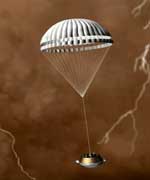A surprising link may exist between ocean fertility and air pollution over land, according to Georgia Institute of Technology research reported in the Feb. 16 issue of the Journal of Geophysical Research – Atmospheres. The work provides new insight into the role that ocean fertility plays in the complex cycle involving carbon dioxide and other greenhouse gases in global warming.
When dust storms pass over industrialized areas, they can pick up sulfur dioxide, an acidic trace gas emitted from industrial facilities and power plants. As the dust storms move out over the ocean, the sulfur dioxide they carry lowers the pH (a measure of acidity and alkalinity) level of dust and transforms iron into a soluble form, said Nicholas Meskhidze, a postdoctoral fellow in Professor Athanasios Nenes’ group at Georgia Tech’s School of Earth and Atmospheric Sciences and lead author of the paper “Dust and Pollution: A Recipe for Enhanced Ocean Fertilization.”
This conversion is important because dissolved iron is a necessary micronutrient for phytoplankton – tiny aquatic plants that serve as food for fish and other marine organisms, and also reduce carbon dioxide levels in Earth’s atmosphere via photosynthesis. Phytoplankton carry out almost half of Earth’s photosynthesis even though they represent less than 1 percent of the planet’s biomass.
In research funded by the National Science Foundation, Meskhidze began studying dust storms three years ago under the guidance of William Chameides, Regents’ Professor and Smithgall Chair at Georgia Tech’s School of Earth and Atmospheric Sciences and co-author of the paper.
“I knew that large storms from the Gobi deserts in northern China and Mongolia could carry iron from the soil to remote regions of the northern Pacific Ocean, facilitating photosynthesis and carbon-dioxide uptake,” Meskhidze said. “But I was puzzled because the iron in desert dust is primarily hematite, a mineral that is insoluble in high-pH solutions such as seawater. So it’s not readily available to the plankton.”
Using data obtained in a flight over the study area, Meskhidze analyzed the chemistry of a dust storm that originated in the Gobi desert and passed over Shanghai before moving onto the northern Pacific Ocean. His discovery: When a high-concentration of sulfur dioxide mixed with the desert dust, it acidified the dust to a pH below 2 – the level needed for mineral iron to convert into a dissolved form that would be available to phytoplankton.
Expanding on this discovery, Meskhidze studied how variations in air pollution and mineral dust affect iron mobilization.
Obtaining in-flight data from two different Gobi-desert storms – one occurring on March 12, 2001, and the other on April 6, 2001 — Meskhidze analyzed the pollution content and then modeled the storms’ trajectory and chemical transformation over the North Pacific Ocean. Using satellite measurements, he determined whether there had been increased growth of phytoplankton in the ocean area where the storms passed.
The results were surprising, he said. Although the April storm was a large one, with three sources of dust colliding and traveling as far as the continental United States, there was no increased phytoplankton activity. Yet the March storm, albeit smaller, significantly boosted the production of phytoplankton.
The differing results can be attributed to the concentration of sulfur dioxide existing in dust storms, Meskhidze said. Large storms are highly alkaline because they contain a higher proportion of calcium carbonate. Thus, the amount of sulfur dioxide picked up from pollution is not enough to bring down the pH below 2.
“Although large storms can export vast amounts of mineral dust to the open ocean, the amount of sulfur dioxide required to acidify these large plumes and generate bioavailable iron is about five to 10 times higher than the average springtime concentrations of this pollutant found in industrialized areas of China,” Meskhidze explained. “Yet the percentage of soluble iron in small dust storms can be many orders of magnitude higher than large dust storms.”
So even though small storms are limited in the amount of dust they transport to the ocean and may not cause large plankton blooms, small storms still produce enough soluble iron to consistently feed phytoplankton and fertilize the ocean. This may be especially important for high-nitrate, low-chlorophyll waters, where phytoplankton production is limited because of a lack of iron.
Natural sources of sulfur dioxide, such as volcanic emissions and ocean production, may also cause iron mobilization and stimulate phytoplankton growth. Yet emissions from human-made sources normally represent a larger portion of the trace gas. Also, human-made emission sites may be closer to the storm’s course and have a stronger influence on it than natural sulfur dioxide, Meskhidze said.
This research deepens scientists’ understanding of the carbon cycle and climate change, he added.
“It appears that the recipe of adding pollution to mineral dust from East Asia may actually enhance ocean productivity and, in so doing, draw down atmospheric carbon dioxide and reduce global warming,” Chameides said.
“Thus, China’s current plans to reduce sulfur dioxide emissions, which will have far-reaching benefits for the environment and health of the people of China, may have the unintended consequence of exacerbating global warming,” he added. “This is perhaps one more reason why we all need to get serious about reducing our emissions of carbon dioxide and other greenhouse gases.”
Original Source: Georgia Tech News Release



